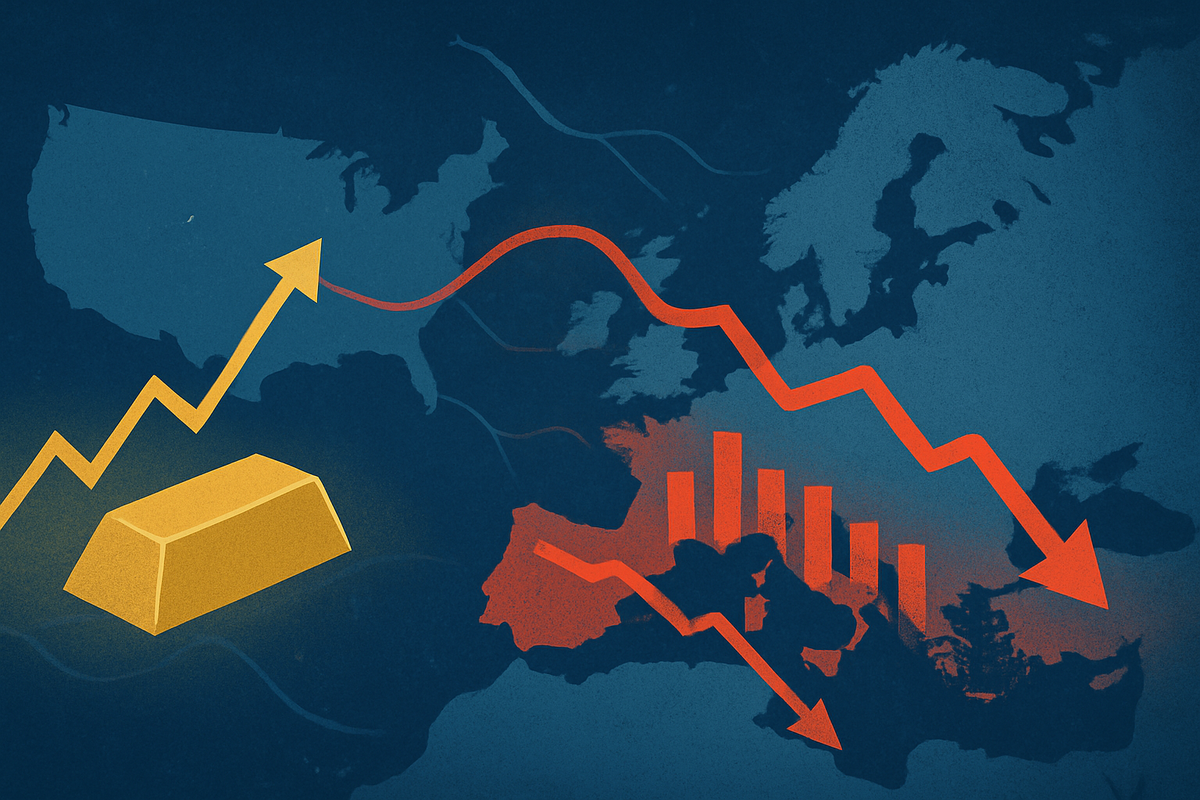
London, October 17, 2025 – European equity markets are experiencing a significant downturn today, as renewed anxieties over the health of US regional banks trigger a global "flight to safety" among investors. The widespread unease, reminiscent of the banking turmoil of 2023, has sent shockwaves across financial sectors, with European financial institutions bearing the brunt of the sell-off. This immediate reaction reflects a deeply ingrained sensitivity within the market to any signs of fragility in the banking system, prompting a swift re-allocation of capital towards traditional safe-haven assets.
The current market apprehension is not merely a localized event but a global phenomenon, underscoring the interconnectedness of international financial systems. As concerns emanating from the US banking sector intensify, investors are shedding riskier assets, leading to a surge in demand for gold, silver, and government bonds. This pronounced risk-off sentiment is creating a volatile environment, challenging investor confidence and forcing a re-evaluation of portfolio strategies amidst the escalating uncertainty.
Unpacking the Contagion: A Detailed Look at the Triggers and Reactions
The immediate catalyst for the current market jitters stems from a series of concerning disclosures and broader worries within the US regional banking sector. Utah-based Zions Bancorporation (NASDAQ: ZION) announced an unexpected $50 million loss on two commercial and industrial loans, citing "apparent misrepresentations and contractual defaults" and "other irregularities" by the borrowers. Concurrently, Arizona-based Western Alliance Bancorporation (NYSE: WAL) initiated a lawsuit alleging fraud by a borrower over a bad loan reportedly worth $100 million. These isolated incidents, though seemingly contained, have amplified existing concerns about overall credit quality within US regional banks, particularly in the private credit markets, where some analysts are noting a rise in credit impairments and default rates.
Adding to the unease is the banking sector's exposure to recent bankruptcies of two US auto-related companies, First Brands and Tricolor, which has rekindled worries about lending standards and the potential for a wave of non-performing loans. The specter of Commercial Real Estate (CRE) exposure also looms large, with regional banks holding a disproportionate 44% of their loan portfolios in CRE, compared to just 13% for larger banks. Elevated interest rates and declining property values, especially in the office sector where delinquency rates are nearing 10.4%, exacerbate this vulnerability. These factors, combined with the lingering memory of the Silicon Valley Bank collapse in 2023, have made investors highly sensitive to any signs of stress. JPMorgan Chase (NYSE: JPM) CEO Jamie Dimon's recent cautionary remark, "When you see one cockroach, there are probably more, and so everyone should be forewarned," has further fueled investor anxiety, suggesting a deeper underlying issue within the financial system.
The market's reaction has been swift and severe across continents. European equities, in particular, have seen sharp declines, with the pan-European banking industry losing over €45 billion in value. Major European banks such as Deutsche Bank AG (XTRA: DBK), Barclays PLC (LSE: BARC), Societe Generale SA (EPA: GLE), Banco Santander SA (BME: SAN), UBS Group AG (SWX: UBSG), and BNP Paribas SA (EPA: BNP) all experienced significant falls, with some sliding as much as 6%. The FTSE 100 (LSE: UKX), Germany's Dax (XTRA: DAX), and France's Cac 40 (EPA: PX1) indices all recorded substantial drops, reflecting the widespread panic. This downturn was not confined to Europe; Asian financial stocks also sank, and Wall Street experienced a mixed open with US regional bank stocks under considerable pressure, highlighting the global nature of this financial contagion.
The Winners and Losers: Companies Navigating the Storm
In this environment of heightened financial uncertainty and a pronounced flight to safety, certain companies and sectors are inevitably poised to win, while others face significant headwinds. The most immediate losers are undoubtedly the European and US regional banks. Shares of Zions Bancorporation (NASDAQ: ZION) and Western Alliance Bancorporation (NYSE: WAL) have seen considerable declines following their respective loan loss announcements and fraud allegations, further eroding investor confidence in the regional banking sector. European counterparts like Deutsche Bank AG (XTRA: DBK), Barclays PLC (LSE: BARC), and Societe Generale SA (EPA: GLE) are suffering from the broader contagion effect, as investors indiscriminately pull capital from financial institutions perceived to be at risk, regardless of their direct exposure to the specific US issues. These banks face not only immediate stock price depreciation but also potential difficulties in accessing capital markets, increased funding costs, and stricter regulatory scrutiny. Their profitability could be squeezed by rising provisions for bad loans and a general slowdown in lending activity as economic uncertainty grows.
Conversely, the "flight to safety" narrative is creating clear winners in the precious metals and safe-haven asset sectors. Gold miners, such as Barrick Gold Corporation (NYSE: GOLD) and Newmont Corporation (NYSE: NEM), are experiencing a surge in their stock values as gold prices hit a new record high, breaching $4,300 per ounce. Similarly, companies involved in silver mining and trading are benefiting from silver's dramatic ascent beyond $54 per ounce. These companies offer investors a tangible store of value during times of market turmoil, making them attractive alternatives to volatile equities. Furthermore, entities that facilitate the trading and custody of government bonds, particularly US Treasuries, are seeing increased activity. While not directly "companies," the market for these instruments thrives on uncertainty, leading to lower yields as demand pushes prices up.
Beyond direct financial institutions and safe-haven plays, companies with robust balance sheets, strong cash flows, and minimal exposure to speculative credit markets or commercial real estate are likely to weather the storm more effectively. Large-cap, diversified corporations in stable sectors, often considered "quality" stocks, may see a relative outperformance as investors seek stability. However, any company reliant on easy credit or operating in highly cyclical industries could face challenges as lending tightens and economic growth prospects dim. The ripple effect could also benefit certain fintech companies offering alternative lending solutions or robust risk management platforms, provided they can demonstrate resilience and avoid the pitfalls currently plaguing traditional banks.
Broader Implications: A Shifting Financial Landscape
This current episode of market contagion, triggered by US bank jitters, is not an isolated incident but rather fits into broader industry trends that have been developing for some time. The heightened sensitivity to regional bank health underscores persistent concerns about the post-pandemic financial landscape, particularly the vulnerability of smaller institutions to interest rate shocks and asset quality deterioration. The significant exposure of regional banks to Commercial Real Estate (CRE) debt, combined with rising delinquency rates in the office sector, represents a systemic risk that has been simmering for years. This event could accelerate the deleveraging of CRE portfolios and force a re-evaluation of lending practices across the board, potentially leading to a more conservative lending environment. Furthermore, the spotlight on "private credit markets" and rising credit impairments suggests that risks have been migrating outside of traditional banking, creating new, less transparent areas of concern for regulators and investors alike.
The potential ripple effects extend far beyond the immediate banking sector. Competitors, particularly larger, more diversified financial institutions like JPMorgan Chase (NYSE: JPM) or Bank of America Corporation (NYSE: BAC), might initially face contagion-driven sell-offs but could ultimately benefit from a "flight to quality" within the banking sector if smaller regional players continue to struggle. This could lead to further consolidation in the banking industry, as stronger banks acquire weaker ones. Partners across the financial ecosystem, from asset managers to fintech providers, will need to adapt to a potentially tighter credit market and increased regulatory scrutiny. The event also has significant regulatory and policy implications. Policymakers, still haunted by the 2008 financial crisis and the 2023 regional bank failures, are likely to intensify their oversight of regional banks, particularly concerning their CRE exposure and risk management practices. There could be calls for stricter capital requirements, enhanced stress testing, and more robust liquidity frameworks for smaller institutions to prevent future contagions.
Historically, periods of banking sector stress have often led to significant shifts in the financial landscape. Comparisons can be drawn to the 2023 collapse of Silicon Valley Bank (OTC: SIVBQ) and Signature Bank (OTC: SBNY), which also triggered a flight to safety and highlighted vulnerabilities in regional banking models. The current situation, however, appears to be driven by credit quality concerns rather than interest rate duration mismatches, indicating a different facet of risk. Another historical parallel might be found in episodes of broader credit market tightening, where isolated defaults snowball into wider concerns about systemic risk. The "AI bubble" fears mentioned by some analysts also add a layer of complexity, suggesting that a broader market correction might be overdue, with banking jitters merely serving as a trigger for a wider reassessment of asset valuations.
The Road Ahead: Navigating Uncertainty
Looking ahead, the short-term outlook for European and global markets remains highly volatile, dominated by the ongoing US bank jitters and the overarching flight to safety. Investors should brace for continued fluctuations as market participants digest new information regarding loan losses, credit quality, and potential regulatory responses. In the immediate future, we can expect sustained demand for safe-haven assets, with gold and silver likely to maintain their elevated prices, and government bond yields remaining suppressed. Equity markets, particularly financial stocks, will likely remain under pressure until there is clearer evidence that the contagion is contained and that underlying credit issues are not widespread. Short-term strategic pivots for investors might include increasing allocations to defensive sectors, high-quality dividend stocks, and maintaining a higher cash position to capitalize on potential buying opportunities.
In the long term, the current events could instigate significant shifts in the financial industry. A prolonged period of tighter credit conditions, particularly for commercial real estate and private credit, could lead to a slowdown in economic growth. This might force banks to adapt their business models, focusing more on fee-based services and less on traditional lending in riskier segments. Regulatory bodies are almost certain to implement more stringent oversight, potentially leading to increased compliance costs for regional banks and further consolidation within the sector. Market opportunities may emerge for well-capitalized institutions to acquire distressed assets or expand market share from struggling competitors. For investors, this environment could present opportunities in sectors resilient to economic downturns, such as utilities, healthcare, and technology companies with strong recurring revenue models, once the initial panic subsides.
Potential scenarios and outcomes range from a relatively quick containment of the jitters, leading to a market rebound, to a more prolonged period of financial stress if credit issues prove to be more systemic than currently understood. A "soft landing" scenario would involve central banks and regulators successfully intervening to stabilize markets and restore confidence, preventing a widespread credit crunch. Conversely, a "hard landing" could see the banking jitters escalate into a broader economic downturn, characterized by a significant tightening of credit, increased corporate defaults, and a sustained equity market bear run. Investors should closely monitor macroeconomic indicators, central bank communications, and the financial health of regional banks, paying particular attention to their commercial real estate exposure and loan loss provisions, as these will be key determinants of the market's trajectory in the coming months.
Concluding Thoughts: Resilience in a Volatile Market
The current market turmoil, stemming from US bank jitters and manifesting as a flight to safety in European equities, serves as a stark reminder of the interconnectedness and inherent fragilities within the global financial system. The immediate takeaways are clear: investor confidence in regional banking remains highly sensitive, credit quality concerns are paramount, and the allure of safe-haven assets intensifies during periods of uncertainty. The rapid sell-off in European financial stocks underscores the speed with which contagion can spread across borders, necessitating vigilant risk management and a diversified investment approach.
Moving forward, the market will be defined by its resilience and ability to absorb these shocks. While the current environment presents significant challenges, it also highlights the importance of fundamental analysis and a long-term perspective. The banking sector, particularly regional players, will face ongoing scrutiny regarding their loan portfolios, capital adequacy, and risk management practices. This period of heightened volatility may ultimately lead to a healthier, albeit potentially smaller, regional banking sector as weaker institutions are either consolidated or forced to strengthen their balance sheets.
Investors should remain cautious but not panicked. The focus should be on quality companies with strong fundamentals, manageable debt, and robust cash flows that can withstand economic headwinds. Diversification across asset classes and geographies remains crucial. Closely watching regulatory responses, central bank policies, and the evolution of credit market conditions will be paramount in the coming months. This event, while disruptive, offers a critical opportunity for investors to reassess their risk tolerance and reinforce their portfolios against future market shocks, ultimately fostering a more resilient and informed investment strategy.
This content is intended for informational purposes only and is not financial advice






